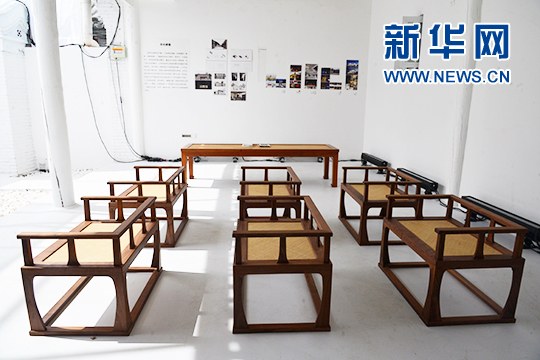Shichahai in downtown Beijing is a popular tourist destination for visitors near and far, who come to appreciate the beauty of its many hutongs and traditional courtyards. This has also become a favourite spot for architects, who are trying to revitalize the neighborhood and invigorate the ageing local community through a series of architectural and cultural projects. Encountering Beijing, is one such example and it's revealing an architectural approach to urban upgrading.

Shichahai in downtown Beijing is a popular tourist destination for visitors near and far, who come to appreciate the beauty of its many hutongs and traditional courtyards.
These two aunties never imagined that they would one day see giant photos of their neighbors being displayed in an exhibition. The people in the still frames are not celebrities, but common people living in Beijing's Shichahai community.
The exhibition is part of professor Liu Kecheng's joint project with photographer Chong'er. The two are aiming to transform the ordinary courtyard No.5 of Jinjiang Hutong, into a community library and a bed-n-breakfast accommodation where travelers can mingle with the locals and learn more about their life style.
"The government purchased this property after the former owner left the premise. There's a pubic toilet right beside the entrance to the courtyard. We had been thinking about what this area can be transformed into for the public. After some research we found out that the neighborhood needs a place for people to meet and talk and can help foster emotional bonds. A library was thought to be a good idea. The book collection can be loaned from public libraries or donated. And a b-n-b accommodation also seemed fitting for the courtyard. And the folks who live here shall take on the responsibilities of running the library, as a way to get closer to the community," said professor Liu Kecheng, Xi'an University of Architecture & Technology.
Liu says he's happy to see hutong residents support the project. Some offer ideas and suggestions, or have volunteered to help with construction, while others have even brought along their own birdcages to help with the decor.
Upon entering No.14 of Weikeng hutong, two giant trees steal the bulk of your attention. On one side of the courtyard visitors can sit down to have a cup of coffee and grab a book to read. On the other side, they will find video projections and illustrations that detail the designer's approach to upgrading the area.
Wang Weiren, the mastermind behind the project, explains what he attempts to do, given the existing conditions of the buildings and trees in the area.
"For the two trees we want to incorporate them for daily life activities from the community, as well as users of the library. We created benches and counters that people can sit on, with a view of the trees. For the future project, we'd also like to use any opportunity than can amplify the relationship between the design elements. We'll make four corners with each becoming a pavilion,and a small patio. So people will be able to look at the trees in a different way," said professor Wang Weijen, Chinese Architecture & Urban Design, the University of Hong Kong.

Shichahai in downtown Beijing is a popular tourist destination for visitors near and far, who come to appreciate the beauty of its many hutongs and traditional courtyards.
At the on-going Beijing Design Week, nine architects have chosen nine traditional courtyards in Shichahai as their subjects for exploration and innovation.
"Encountering Shichahai aims to revitalise the ageing neighborhood. Nine architects united with nine design brands are joiming hands in creating a better living environment for the locals. Out of hundreds of courtyards, we finally chose nine with different characteristics and sizes. All architects' projects are being displayed during Beijing Design Week. After that, architects will continue upgrading the courtyards and deepening their creative concepts, and thus complementing the sustainability of the program," said Peng Lixiao, chief editor of Urban Environment Design.
In the meantime, a dialogue between Chinese architects and their South Korean counterparts is also happening in Shichahai. They are discussing the possibilities of urban upgrading and cultural protection from an architectural perspective.
"Both Seoul and Beijing confront the destiny of fast urbanization. During that period many buildings were demolished in Seoul, so the city lost lots of its memories. Now we are reflecting on ourselves, what we have done and are trying to make up for that. I hope Beijing will not repeat our mistakes in the past. Although great changes have taken place in Beijing, the city has well maintained its historical sites such as Shichahai. A city consists of memory and desire. A city without memory will not develop in a benign manner," said Seung H-Sang, Korean architect.
Apart from the exhibition, "Encountering Shichahai" also includes music and dance performances, lectures and talks. It runs in the Shichahai area until October 7th.















